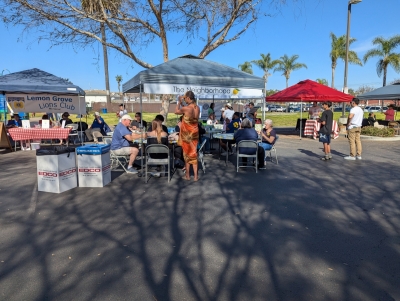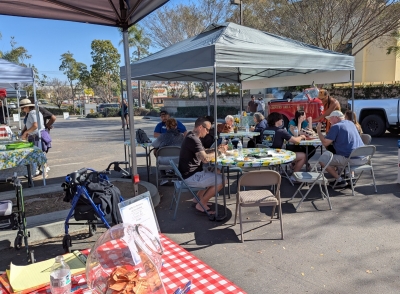EL CAJON CITY COUNCIL’S FIRE DEPARTMENT COVERAGE WORKSHOP

By G. A. McNeeley
February 15, 2025 (El Cajon) - The El Cajon City Council, city staff, Heartland Fire Department and labor representatives came together on Wednesday to discuss possible short-term options, to staff a newly purchased fire engine, after a grant failed to fund.
Last year, the City Council explored options to augment fire and medical response coverage throughout the city. The Council directed staff to acquire an additional fire engine and seek a grant to fund the staff to operate that engine. Although the engine was acquired, the City was not successful in obtaining the grant. Their intent was to operate the engine (E-208) out of Station 8 as a full service vehicle, staffed with nine new employees. The grant would have paid for the majority of those employees.
On February 12, a workshop was held at the El Cajon City Council Chambers to discuss options that the City Council may wish to pursue in light of not receiving the grant. As part of its presentation, staff provided an update on data presented in 2024. The staff also presented short-term options for the City Council to consider.
Background Information
Staff reported that call volumes have been going up for the fire department in recent years.
For example, the fire department received 9,556 calls for response in 2003, 10,246 calls in 2008, 11,863 calls in 2013, 15,802 calls in 2018, 17,928 calls in 2023, and 17,574 calls in 2024.
Between 9:00 a.m. and 8:00 p.m. are the busiest hours for Heartland Fire Department in El Cajon.
El Cajon’s turnout time is an average of 2:00 minutes, with a total response average of 9:22 minutes. You can compare this to La Mesa and Lemon Grove, who have a turnout time with an average of 2:17 minutes and 2:05 minutes respectively, and a total response average of 10:47 minutes and 9:28 minutes respectively.
Turnout Time & Total Response per Station: Station 6 (1:56 & 9.21), Station 7 (1:57 & 10:57), Station 8 (2:08 & 9:03), and Station 9 (1:58 & 10:23).
2,512 calls were made in 2023, and 2,567 calls were made in 2024, into the city. That is a change of +2.2%. 1,743 calls were made in 2023, and 1,895 were made in 2024, outside of the city. That is a change of +8.7%. That is a difference of 769 calls in 2023, and 672 calls in 2024, or 2.1 calls per day in 2023, and 1.8 calls per day in 2024.
Aid that was provided between 2023 and 2024 into the city included Station 8 (596 to 546), Station 9 (477 to 496), Station 6 (394 to 416), and Station 7 (276 to 437).
Aid that was provided between 2023 and 2024 to other cities includes San Miguel (1,430 to 1,487), Lakeside (674 to 710), La Mesa (277 to 254), and Santee (131 to 116).
The total number of calls made to Congregate Care Facilities in 2023 was 1,648, and the total number of calls made in 2024 was 1,506. That was an average of 4.5 calls per day in 2023, and an average of 4.1 calls per day in 2024. An average of 2.8 calls per day in 2023, and 2.6 calls per day in 2024 were made between 8 AM and 8 PM. An average of 1.2 calls per day in 2023, and 1.3 calls per day in 2024 were given to Engine 8, while an average of 3.2 calls per day in 2023, and an average of 2.8 calls per day in 2024 were given to Engine 6, Squad 6, and Truck 6. The daily average of homeless related calls was 3.7.
In 2023, 2,540 calls were Low/Mid Acuity Medical (Squad Assessable), 1,286 calls were Complex Medical, and 918 calls were either Fire Related, Traffic Related, Hazard Mitigation, Equipment/Supervisor Required, or Rescue.
The Response Comparison by Station in 2023 and 2024, included Station 6 (9,327 to 9,032), Station 8 (4,773 to 4,747), Station 9 (2,041 to 1,706), and Station 7 (1,566 to 1,170).
Short-Term & Long-Term Goals
The long-term goal for El Cajon is to build a fifth fire station. Their short-term objectives include continuing to reduce citywide calls by using regional nurse navigation, congregate care facilities, and education, and reducing Engine 8 calls to reduce the strain off of Station 6 and reducing the imbalance of Charge Aid.
Their first short-term coverage option was to add an Advanced AMR at Station 8. The shifts would be 12 hours, and it would operate similarly to Squad 6, but with contracted staff. This would cost $612,149, and reduce calls by 1,750 (or $350 per call, and 4.8 calls per day). This also wouldn't help with training coverage.
Their second short-term coverage option was fully staffing Engine 208, for 7 days a week, and 12 hour shifts. This would cost $1,733,000, and would reduce calls by 2,220 (or $788 per call, and 6 calls per day). This would also come with hybrid staffing challenges.
Their third short-term coverage option was fully staffing Engine 208, with 24 hour shifts. This would cost $2,610,000, and would reduce calls by 3,050 (or $856 per call, and 8.35 calls per day). This would mean that the city would no longer be eligible for the SAFER grant.
Their last short-term coverage option was the one-third option, which involved extra staff on the A-Shift, but no extra staff on B-Shift or C-Shift (they’d have the same amount they already have). However, this option is explained better, later in the article. This would cost $870,000, and reduce calls by 1,575 (or $552 calls per call, and 4.3 calls per day). This would also come with hybrid staffing challenges.
Where might funding come from for any of the above?
The staffer provided examples of some city expenditures, which might potentially be reduced:
Code Enforcement and Online Permitting (2 Planners) costs $750,000. One Forensics Lab costs $1 Million. Four Recreation Centers cost $1 Million. Reducing Non-Public Safety Positions by 5% costs $1 Million. Fire Department Overtime costs $2.64 Million. The Finance Department costs $2.86 Million.
Opinions
Simon Garcia, labor representative for “The Local 46,” has been with the city since 2005. He said that they were inclined to go with the full engine staffing with city firefighters (not contracted with AMR).
“However, as a labor group, we’d like to collaborate with the city council, city staff, and the fire department in order to get to that goal.”
They were not in favor of the AMR unit, stating that this would be a disservice to the community. An AMR unit doesn't have the same training, and they can’t cover for city firefighters during their unit training. Garcia added, “Our department is very highly trained, and provides the best service to our community, and that would be a decrease in service in our opinion.”
They were also not inclined to go with the 12-hour option, because it was 66% percent of the cost, with 50% of the coverage.
However, they were also willing to compromise, by going with some partial staffing, and to try to reapply for the SAFER grant. With this option, they would start out with giving extra coverage to just the A-Shift. The idea they suggested was to slowly be able to hire extra coverage for the B-Shift, and then eventually the C-Shift.
Most of the speakers were in favor of the full staffing option, and said that the biggest obstacle is funding. Without going back to voters, for a quarter percent tax increase, the other option would be 5% cut in staffing across many city departments.
The Council directed City Manager Graham Mitchell to “prepare a budget plan on how to fund the full staffing of Engine 208, with the realization that hiring one company at a time may be more of a reality than the three it requires to run 24/7/365,” according to Mitchell.
The City also hopes to reapply for the SAFER grant this fall.









